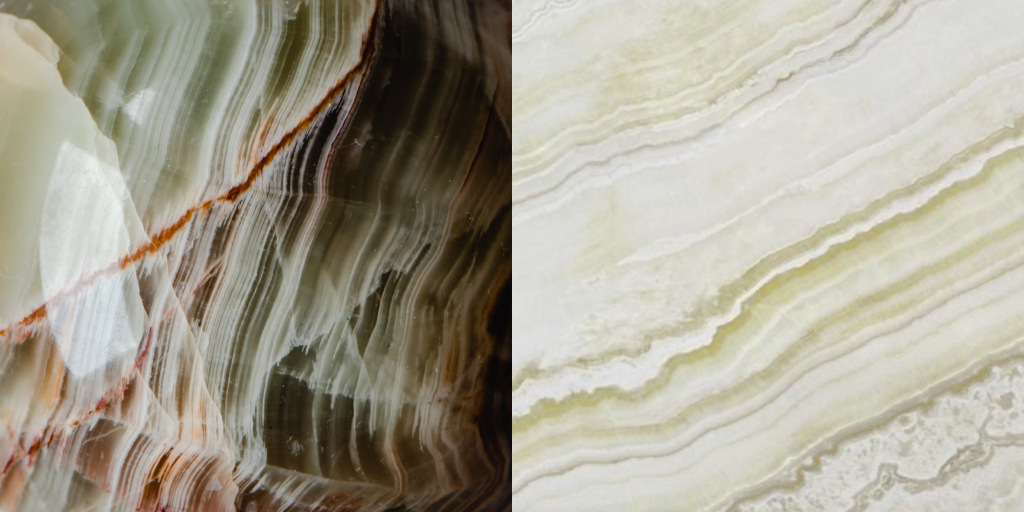Onyx: Hard or Soft Stone?
It may be that you have been researching natural onyx in an effort to determine if it is right for your shop. Or perhaps you are researching the material because you are thinking of using it in your own project? Whether you are a professional or a consumer you may be interested in natural onyx for a project. In researching onyx you likely found some information talking about how hard the material is and other material describing it as a soft stone. You may be asking yourself, “so which is it, is onyx a hard stone or soft?” In this post we will take a look at onyx and why there seems to be so much conflicting information when you research onyx.

Gemstones and Surface Materials
One of the things that becomes clear if you research onyx long enough is that the term is used for more than one material. Onyx is a natural gemstone and much of the information you will find online speaks directly about the gemstone that is called onyx. However, the term “onyx” is also used in the commercial stone industry to describe a specific countertop surface as well. We recently compared onyx vs quartzite here on this website and you might find it interesting to read.
Onyx Gemstones are Hard
The first of the two materials mentioned above is the one that is described as a hard material. Note what the Wikipedia.org page for onyx says about the stone. Here is a quote from that page:
Onyx is a gemstone found in various regions of the world including Greece, Yemen, Uruguay, Argentina, Australia, Brazil, Canada, China, Czech Republic, Germany, Pakistan, India, Indonesia, Madagascar, Latin America, the UK, and various states in the US.
As you can see in quote above, this page talks about the gemstone onyx. The information goes into some detail about the minerals and formulas associated with this material. But the key point that we want to zero in on is the identification information on that page on the right. The Mohs scale hardness is listed at 6.5-7. That is pretty hard. Additionally, the formula is SiO2 (Silica). The information on the page goes on to state that the material consists of the minerals quartz and moganite.
Onyx Surfaces are “Soft”
The other type of onyx that we will discuss here is the surface material. The Wikipedia page quoted above also says the following:
Onyx, as a descriptive term, has also been applied to parallel banded varieties of alabaster, marble, calcite, obsidian and opal, and misleadingly to materials with contorted banding, such as “Cave Onyx” and “Mexican Onyx”.
This is in relation to the materials used for surfaces in kitchens of homes and other areas as well. The type mentioned there is what one geologist that writes for UseNaturalStone.org describes this way:
In the commercial stone industry, onyx refers a category of stones that are made of layered bands of light-colored or translucent minerals. Most slabs of onyx are what a geologist would call banded calcite. This same material also goes by the names onyx marble, Mexican onyx, or Egyptian alabaster.
She then goes on to say the following:
Onyx is commercially classified as a sibling to marble because these two stones have the same mineral content. Onyx is made of calcite, which is the same mineral that makes up limestone, marble, and travertine. In fact, banded calcite is a close cousin of travertine and forms in a similar way.
Calcareous Stone is Soft
Natural stone that is made up of calcium carbonate (or calcite) is called calcareous stone. The stones marble, limestone, and travertine mentioned above are all calcareous stones. Additionally, the “commercially classified” onyx about which this article speaks is also calcareous.
Calcareous stone is relatively soft as far as stone is concerned. That is not to say that it is too soft to be used for a countertop. On the contrary, calcareous stone is definitely hard enough to be used as a countertop material. In fact, onyx is used for countertops and bar tops. But, calcareous stone is just not as hard as other stone. Commercially classified onyx registers much lower on the Mohs scale than the gemstone onyx we mentioned above. Onyx surfaces have a hardness of more like 3-4. So commercially classified onyx is easier to scratch than the gemstone because it is softer.
Answering the Original Question
So to answer to question we raised at the beginning of this post, “Is onyx a hard stone or soft?” There are a variety of ways that could be answered. For example, one could say, “it is both”, someone else might say, “onyx is a hard gemstone”, and still yet someone else could say, “onyx is a natural countertop material” that is relatively soft.
The key to being able to sort out all the differing answers you may come across on the Internet is to determine what kind of onyx is being spoken of. Knowing that will help put the statements into perspective. Knowing which material is being spoken of will add clarity to the subject about which you are reading and it will reduce confusion.
In conclusion, you will find online various descriptions of what can be called “natural onyx”. And some of it is hard and some of it is soft. The key is to understand what the material is and get reliable information about that particular material since the term onyx can be used as a geological classification or a commercial one.
